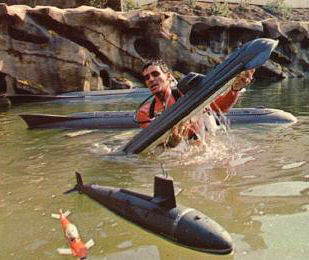 |
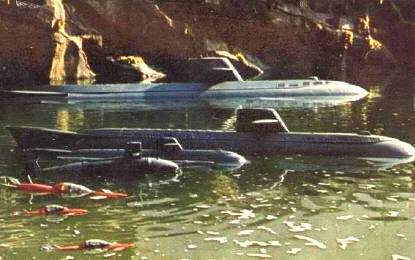 |
Voyage to the Bottom of the Sea
Special Effects The Old Fashioned Way
 |
 |
| All in a day's work. A romp in the back-lot pool with some of his toys. Above left, Voyage's David Hedison in the drink holding up the four-foot model of Seaview, the eight-foot submersible and eighteen-foot version used for surface shots in the background. In the foreground, a generic teardrop Navy sub (31 inches) and a 12-inch miniature of the mini-sub (gee--and we thought they'd all been blown up.) Above right, note different scale mini-subs. |
|
How to launch an eighteen foot miniature submarine. OK. So it's not as high tech as you might think. Many of Voyage's special effects were of the wire, tape and rubber band school that special-effects whiz L.B. Abbott writes about in his book, Special Effects. In the foreground, note the flying saucer used in one of Voyage's most thoughtful science fiction outings, "The Sky is Falling". |
|
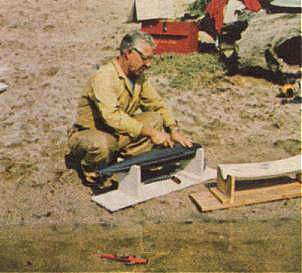 |
|
| The 18 foot model of Seaview appears much bigger than it actually is when filmed high speed and played back at normal speed. As L.B. Abbott writes in his book, Special Effects--Wire, Tape and Rubber-Band Style, "There is an empirical rule governing the camera speeds used for various scale miniatures. | 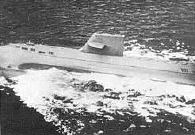 |
| The rule is that the camera speed should be the square root of the miniature scale." Since the 18-foot Seaview was built approximately 1/32nd scale, the film was run through the camera at 136 frames per second during filming. When played back at the normal 24 frames per second, the slow-motion effect gives the illusion that the waves are much larger than they really are--and in fact in scale with a submarine in excess of 600 feet long. The surface action of the water was agitated by large fans and the effect augmented by wave generators in the pond itself. |
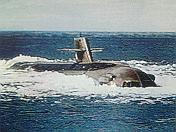 |
Additionally, air forced through vents in the side of the model added to the effect of a large vessel plying the ocean's surface. The critical factor in making surface water shots look real lies in the scale of the miniatures. They have to be sufficiently large, which is why the 18 foot Seaview was use in all such sequences. |
|